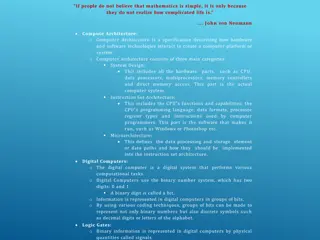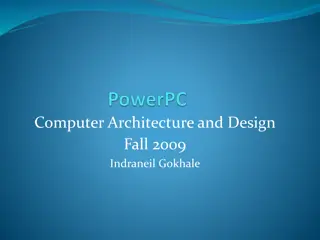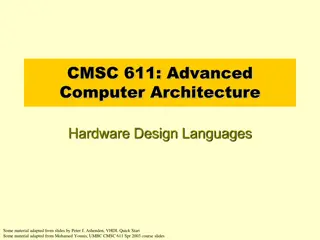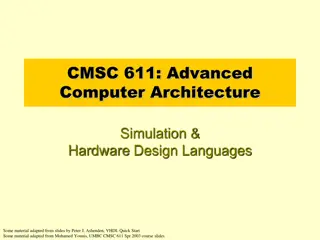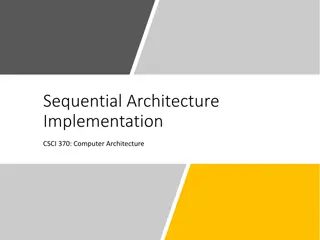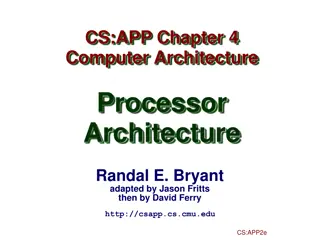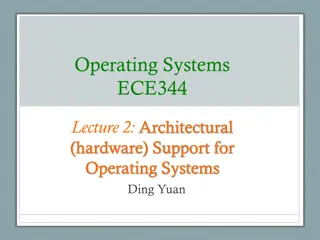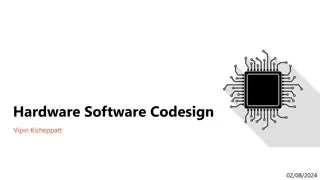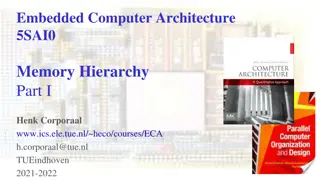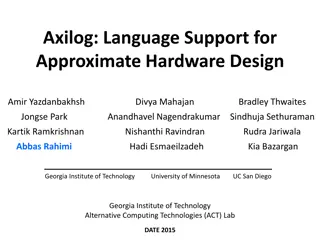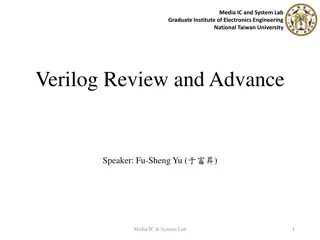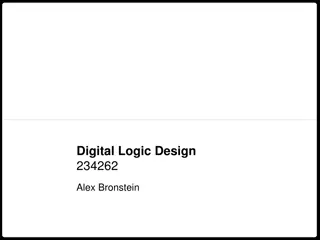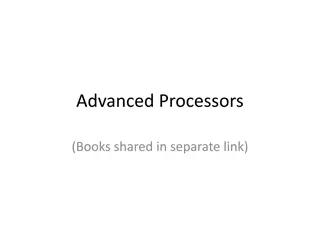
Learn VLSI System Design - Crash Course 2019
"Explore the world of VLSI system design with a crash course covering SystemVerilog, architecture design, protocols, and advanced features. Discover the evolution from Verilog to SystemVerilog and the introduction of new logic data types. Dive into built-in functions, multi-dimension signal handling, and more."
Download Presentation

Please find below an Image/Link to download the presentation.
The content on the website is provided AS IS for your information and personal use only. It may not be sold, licensed, or shared on other websites without obtaining consent from the author. If you encounter any issues during the download, it is possible that the publisher has removed the file from their server.
You are allowed to download the files provided on this website for personal or commercial use, subject to the condition that they are used lawfully. All files are the property of their respective owners.
The content on the website is provided AS IS for your information and personal use only. It may not be sold, licensed, or shared on other websites without obtaining consent from the author.
E N D
Presentation Transcript
Hardware Architecture Design Media IC and System Lab VLSI Crash Course 2019
Outline System Verilog introduction Architecture Design Protocols
History Improved version of Verilog Verilog 1995, 2001(most popular), 2005 SystemVerilog 2005, 2009, 2012 What s new? Some handy features for simplifying RTL coding Many features for verification EDA tool support? Good supports from commercial tools
Features logic data type clog2 Multi-dimension signals Simpler for loop Improved always block
The New Logic Data Type ( ) Reason: The datatype isn t equal to the real circuit. reg doesn t mean a register. It depends on how you use these variables. So, in SystemVerilog, a new type logic is introduced to replace both of them. wire for continuous assignment (assign) reg for procedural assignment (within always block) Flip-Flop must be the data type of reg
The New Logic Data Type ( ) Since logic is useful, you can do this: module MyModule( input a, output reg b, input c, output wire d, module MyModule( input logic a, output logic b, input logic c, output logic d,
The New Built-In Functions ( ) $clog2() ceil(log2(x)). Someday you write: parameter MAX_NUM = 6; parameter BIT_NEED = 3; // 6 requires 3 bits logic [BIT_NEED-1:0] counter; The second day: parameter MAX_NUM = 100; // Advisor says that... parameter BIT_NEED = 3; // You forget it The SystemVerilog version: parameter BIT_NEED = $clog2(MAX_NUM);
Multi-Dimension Improvements ( ) module AddFourNumber( input [31:0] a [0:3], input [31:0] b [0:3], output [31:0] c [0:3] ); assign c[0] = a[0]+b[0]; assign c[1] = a[1]+b[1]; assign c[2] = a[2]+b[2]; assign c[3] = a[3]+b[3]; endmodule
Multi-Dimension Improvements 2 ( ) Verilog ports is 1D module AddFourNumber( input [127:0] a, input [127:0] b, output [127:0] c ); assign c[127-:32] = a[127-:32]+b[127-:32]; assign c[ 95-:32] = a[ 95-:32]+b[ 95-:32]; assign c[ 63-:32] = a[ 63-:32]+b[ 63-:32]; assign c[ 31-:32] = a[ 31-:32]+b[ 31-:32]; endmodule
Improved Always Blocks () Replace all always@(*) by always_comb Replace sequential always block by always_ff
Simpler For-Loop () Don t need to declare a global indices integer i; for (i=0; i<10; i=i+1) The SystemVerilog Version is: for (int i=0; i<10; i++)
Assignment vs always block Assignment LHS should be wire RHS can be wire or reg Everything is logic! Begin & end are not allowed Always running Always Block LHS should be reg RHS can be wire or reg Everything is logic! Begin & end are used for multiple statements Triggered by sensitivity lists But you don t need to write them Could be sequential or combinational always_comb for combinational always_ff for sequential (flip-flop) EDA tool can do some checks for you 1-line, if-else and case conditional statements are allowed. Combinational only Combinational only Only 1-line conditional statement is allowed
Pipeline and Parallel Pipeline: different function units working in parallel Parallel: duplicated function units working in parallel
Pipeline Advantages Reduce the critical path Increase the working frequency and sample rate Increase the throughput Drawbacks Increasing latency (in cycle) Increase the number of registers
How to Do Pipelining Put pipelining registers across any feed-forward cutset of the graph Cutset A cutset is a set of edges of a graph such that if these edges are removed from the graph, the graph becomes disjoint Feed-forward cutset The data move in the forward direction on all the edges of the cutset
Notes for Pipeline Pipelining is a very simple design technique which can maintain the input output data configuration and sampling frequency Tclk=Tsample Supported in many EDA tools Effective pipelining Put pipelining registers on the critical path Balance pipelining 10 (2+8): critical path=8 10 (5+5): critical path=5
Parallel Single-input single-output (SISO) system ? ? = ?? ? + ?? ? 1 + ??(? 2) Multiple-input multiple-output (MIMO) system ? 3? = ?? 3? + ?? 3? 1 + ??(3? 2) ? 3? + 1 = ?? 3? + 1 + ?? 3? + ??(3? 1) ? 3? + 2 = ?? 3? + 2 + ?? 3? + 1 + ??(3?)
Parallel system1 Whole system
Notes for Parallel The input/output data access scheme should be carefully designed, it will cost a lot sometimes Tclk>Tsample, fclk<fsample Large hardware cost Combined with pipeline processing
Retiming A transformation technique used to change the locations of delay elements in circuit without affecting the input/output characteristics Reducing the clock period Reducing the number of registers Reducing the power consumption
Reducing the Number of Registers
Reducing the Power Consumption Placing registers at the inputs of nodes with large capacitances can reduce the switching activities at these nodes
Unfolding Unfolding is a transformation technique that can be applied to a DSP program to create a new program describing more than one iterations of the original program To reveal hidden concurrent so that the program can be scheduled to a smaller iteration period To design parallel architecture
Example DSP algorithm ? ? = ?? ? 9 + ? ? Replace n with 2k and 2k+1 ? 2? = ?? 2? 9 + ? 2? = ?? 2 ? 5 + 1 + ? 2? ? 2? + 1 = ?? 2? 8 + ? 2? + 1 = ?? 2(? 4) + ? 2? + 1
Folding Folding transform is used to systematically determine the control circuits in DSP architectures where multiple algorithm operations are time-multiplexed to a single functional unit
What is Hardware Design? Hardware design: design dataflow of hardware first! The same AXI example is simplified to the image below Concrete dataflow first; exact, low level signal and protocol later.
Importance of Protocol in Hardware Design Design as dataflow, implement as protocol. Benefits: Reuse verification. Play-and-Plug. Uniform code. Widely used and easy to understand. Protocol must be simple: Handshake (2-wire) Streaming (1-wire)
The Simplest Streaming Protocol A valid bit indicate whether data bus hold a valid data
Code for Streaming Protocol Simple to understand, easy to use input logic i_valid, i_data; output logic o_valid, o_data; always_ff @(posedge clk or negedge rst) begin if (!rst) o_valid <= 0; else o_valid <= i_valid; end always_ff @(posedge clk or negedge rst) begin if (!rst) o_data <= 0; else if (i_valid) o_data <= i_data; end Clock gating coding style
Easy to Cascade Modules You can easily add new stage to add new functionalities. Input Module A Module B Output Input Module A Module C Module B Output
Easy to Cascade Modules You can also easily broadcasting signals. Input Module A Module B Output Module D Output
But How About Merging? Data might come at different cycle in streaming interface. Input Module A Module B Output Input Module E
The Improved Handshake Protocol A valid bit indicate whether data bus hold a valid data. A ready bit indicate whether the receiver can got it. ack is 0, wait 1 more cycle Done in 1 cycle
Code for Handshake Protocol input logic i_valid, o_ready, i_data; output logic o_valid, i_ready, o_data; assign i_ready = o_ready || !o_valid; always_ff @(posedge clk or negedge rst) begin if (!rst) o_valid <= 0; else o_valid <= i_valid || (o_valid && !o_ready); end always_ff @(posedge clk or negedge rst) begin if (!rst) o_data <= 0; else if (i_valid && i_ready) o_data <= i_data; end Clock gating coding style 2 core logic
Code for Handshake Protocol assign i_ready = o_ready || !o_valid; If the next stage is ready ready to get Or, you are empty ready to get o_valid <= i_valid || (o_valid && !o_ready); Have input data has data at the next cycle Or, have data but can't pass to the next stage
Handshake can Handle Datapath Merging Wait until both ready, then you are ready. Input Module A Module B Output Input Module E
Brief Summarize Streaming (1-wire) protocol. Very simple to use. But large, be sure you can always receive the data. Handshake (2-wire) protocol. Can stop the data input. Very commonly used!! Both make easy-to-understand hardware pipeline. Both are widely used in industries.




